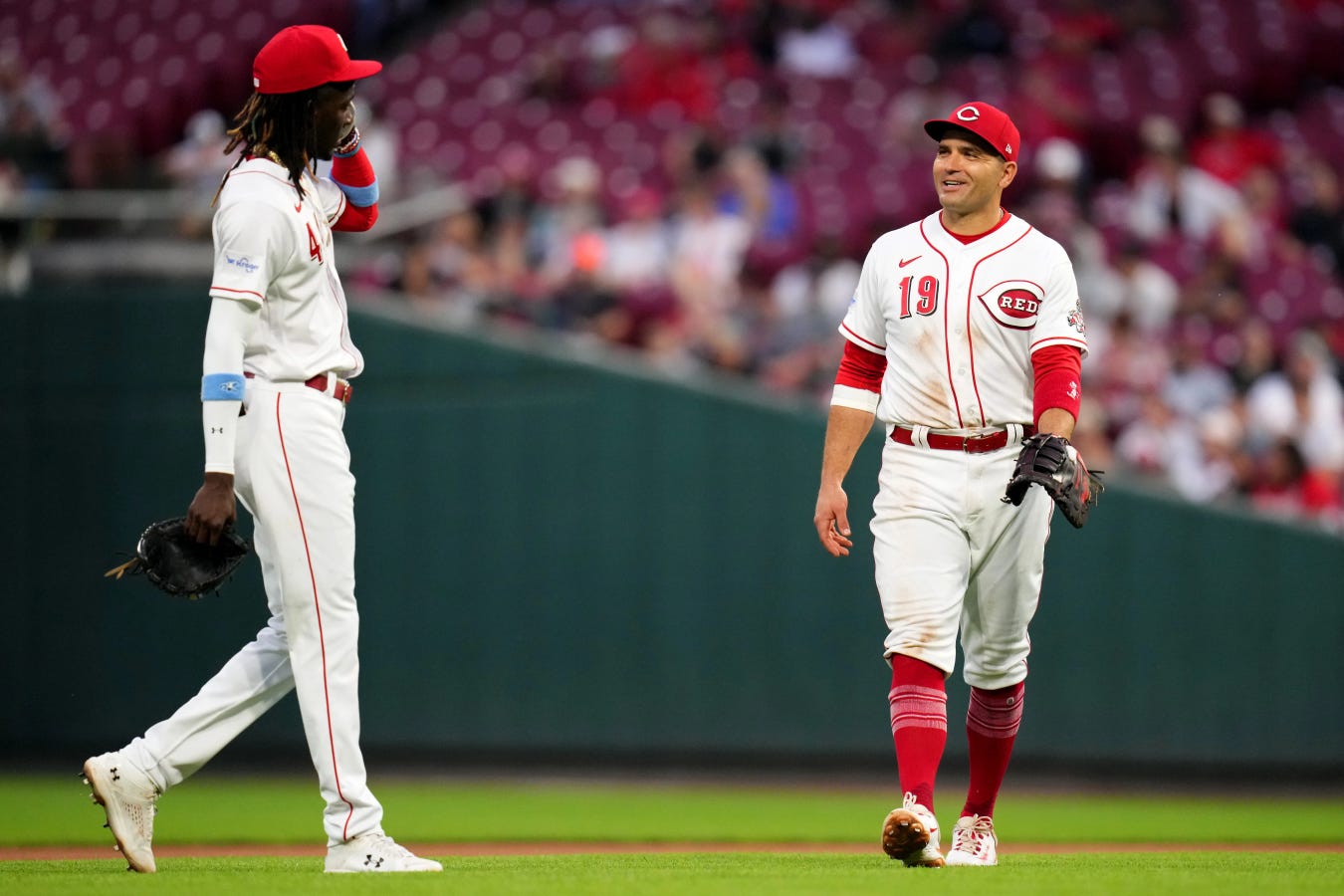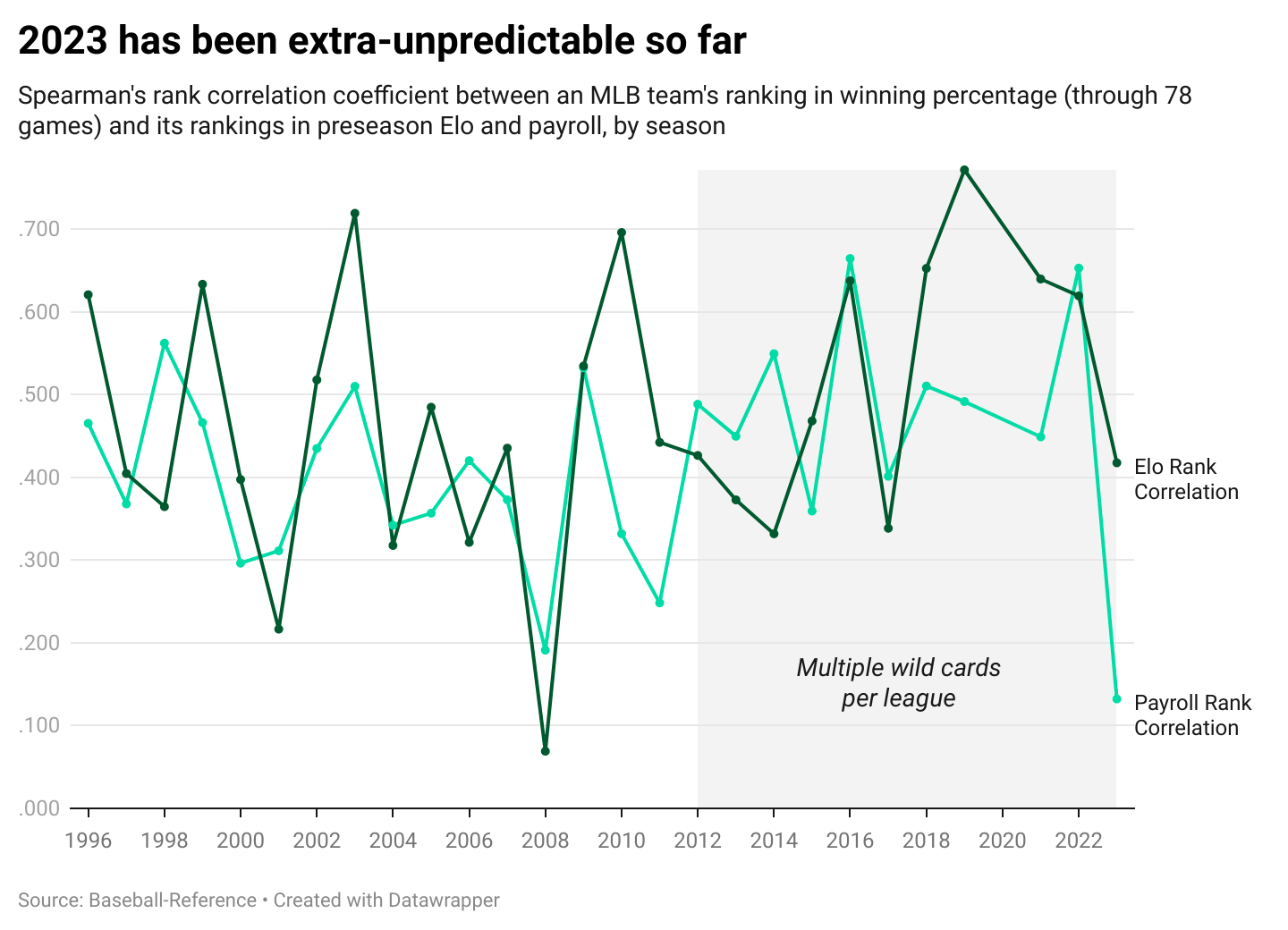This Is One Heckuva Surprising MLB Season
Forecasts — and especially payroll — have been lousy predictors so far.
It’s fair to say this has been a very weird MLB season so far. Maybe it’s teams adjusting to the new rules, maybe it’s just the inherent randomness of baseball that we’d forgotten about during the tanking era. But many of the ballclubs both at the top of the standings and down in the doldrums are extra-surprising as we approach the midpoint of the 2023 schedule.
Consider this: The Texas Rangers, Baltimore Orioles, Arizona Diamondbacks and Miami Marlins all rank among the Top 10 in winning percentage, while the San Diego Padres, New York Mets and St. Louis Cardinals rank among the Bottom 10. That’s wild! And just outside the Top 10, the Cincinnati Reds are currently riding an 11-game winning streak — something the Big Red Machine never did once. What??
We can measure just how unexpected all of this has been in a few ways. First, let’s look at the Spearman rank correlation coefficient between each club’s preseason Elo ranking (a general measure of what a preseason statistical forecast would predict for a team) and their ranking in winning percentage through the first ~78 games in the schedule, for full seasons since 1996.1 This year’s number is 0.417, the lowest in MLB through 78 games since 2017’s 0.338 mark — and the 11th-lowest among the 27 full seasons of our sample.
That correlation is driven most strongly by five different teams with at least a 15-slot differential between their predicted and actual rankings: the Rangers (+20), Marlins (+16) and Reds (+15) on the high side, and the Cardinals (-16) and Mets (-15) on the low side. Only four seasons since 1996 (2008, 2014, 2004, 2001) had more teams miss their projected winning-percentage placement by 15+ ranking slots through 78 games.
But that’s not even what’s making this season feel unpredictable the most. Instead, we have to talk about money not buying wins this year — like, practically at all.
Running the same correlations for payroll rank (according to Baseball-Reference) against winning percentage rank through the first 78 games of each season, 2023’s number is a shockingly low 0.132 — the lowest in our entire sample, in fact. (2008, a notably chaotic year that had the lowest preseason Elo correlation from above, was at 0.191.)
Using the same standard from before — a 15+ place differential in actual versus expected ranking — seven different teams have a gap that large between what they thought their money was buying and what it actually got them: The Rays (+26), Orioles (+25), Marlins (+17) and Diamondbacks (+16) for the good and the Mets (-21), Padres (-17) and Cardinals (-15) for the bad. Five additional squads — the Reds (+12), Braves (+10), Rockies (-12), White Sox (-11) and Phillies (-11) — have at least a 10-slot gap between their payroll and winning percentage ranks, bringing the total in double-digits up to 12 clubs.
What makes all of this more shocking is that the payroll-versus-wins rank correlation through 78 games last season was 0.653 — the second-highest of any season since 1996! And while the Elo-versus-wins correlation wasn’t quite as high, it was still north of 0.6. (The average season is around 0.475.) In other words, MLB was looking a lot more predictable just 365 days ago.
It’s tempting to attribute all of this to the rule changes, since they’re certainly the biggest difference since last season and have certainly created their own list of winners and losers. Maybe the teams exceeding expectations weren’t surprises, but were just built better for the new ways of the game. Maybe the disappointing teams were caught flat-footed by the changes.
Maybe.
But it’s worth pointing out that the rank-correlation between the year-over-year leaders in winning percentage improvement and my MANFRED score — which tried to predict which teams would be able to capitalize more on the new rules, based on their previous performance in categories that would be emphasized going forward — is just 0.120 thus far.
For every team like the D-backs, who improved after ranking highly in categories the new rules favored, the Cleveland Guardians had all of the same hallmarks… and they’ve been one of the more disappointing teams in baseball so far. Whatever the advantage of seemingly being built for the new rules on paper, it’s overshadowed by everything else that encompasses whether a team will be exceed expectations or fall short of them.
Instead, perhaps the chaos of the 2023 season is simply here to remind us that, when it comes to baseball, we never know as much as we think we do.
Filed under: Baseball
The first full 162-game season of the wild-card era, after the ‘94 Strike scuttled the end of the 1994 season and the beginning of 1995.




